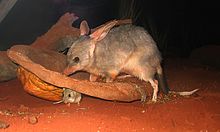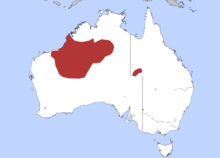- Bilby
-
- This article deals with the species. For the Genus see Macrotis.
Greater Bilby[1] 
Conservation status Scientific classification Kingdom: Animalia Phylum: Chordata Class: Mammalia Infraclass: Marsupialia Order: Peramelemorphia Family: Thylacomyidae Genus: Macrotis Species: M. lagotis Binomial name Macrotis lagotis
Reid, 1837
Distribution of the Bilby The Bilby, Macrotis lagotis, is an Australian species of nocturnal omnivorous animal in the Peramelemorphia order. The common name Bilby usually refers to this species, but is distinguished from Macrotis leucura (the Lesser Bilby) that became extinct in the 1950s by the name Greater Bilby. It is also referred to as the dalgyte or pinkie. The Greater Bilby lives in arid areas of central Australia. Their range and population is in decline.
Contents
Habitat
Once widespread in arid, semi-arid and relatively fertile areas, the Greater Bilby is now restricted to arid wastelands and remains a threatened species. It makes its home in a burrow that spirals down, making it hard for its predators to get in. The Bilby prefers arid habitats because of the Spinifex grass and the acacia shrubs.[3]
Characteristics
Bilbies have the characteristics of long bandicoot muzzle and very long ears. They are about 29–55 centimetres (11–22 in) in length. Compared to bandicoots, they have a longer tail, bigger ears, and softer, silky fur. The size of their ears allows them to have better hearing as well. At 1 to 2.4 kilograms (2.2 to 5.3 lb), the male is about the same size as a rabbit; although male animals in good condition have been known to grow up to 3.7 kilograms (8.2 lb) in captivity. The female is smaller, and weighs around 0.8 to 1.1 kilograms (1.8 to 2.4 lb). The Greater Bilby has an excellent sense of smell and sharp hearing. Its fur is blue-grey with patches of tan and it is very soft. The tail is black and white with a distinct crest. The Greater Bilby has strong forelimbs and thick claws, which it uses to dig for food and make burrows.
Unlike bandicoots, they are excellent burrowers and build extensive tunnel systems with their strong forelimbs and well-developed claws. A bilby typically makes a number of burrows within its home range, up to about a dozen; and moves between them, using them for shelter both from predators and the heat of the day. The female bilby's pouch faces backwards, which prevents her pouch from getting filled with dirt while she is digging.
Bilbies have a very short gestation period of about 12–14 days, one of the shortest among mammals.[4]
Diet
Bilbies are nocturnal omnivores that do not need to drink water, as they get all the moisture they need from their food, which includes insects and their larvae, seeds, spiders, bulbs, fruit, fungi, and very small animals. Most food is found by digging or scratching in the soil, and using their very long tongues.[4]
Conservation
Bilbies are slowly becoming endangered because of habitat loss and change as well as the competition with other animals. Feral cats pose a major threat to the bilby's survival, and there is some competition between Bilbies and Rabbits for food. There is a national recovery plan being developed for saving these animals: this program includes breeding in captivity, monitoring populations, and reestablishing bilbies where they once lived. There have been reasonably successful moves to popularise the bilby as a native alternative to the Easter Bunny by selling chocolate Easter Bilbies (sometimes with a portion of the profits going to bilby protection and research). Reintroduction efforts have also begun, with a successful reintroduction into the Arid Recovery Reserve in South Australia in 2000,[5] and plans underway for a reintroduction into Currawinya National Park in Queensland,[6] with a recent success with six bilbies released into the feral-free sanctuary in early February 2006.
Successful reintroductions have also occurred onto Peron Peninsula in Western Australia as a part of [7] Western Shield. Successful reintroductions have also occurred on other conservation lands, including islands and the Australian Wildlife Conservancy's[8] Scotia[9] and Yookamurra Sanctuaries.[10] There is a highly-successful bilby breeding program at Kanyana Wildlife Rehabilitation Centre,[11] near Perth, Western Australia.
Taxonomy
Nomenclature
A scientific description of the bilby was first published in 1837 by a Mr J. Reid. Reid based his description on a specimen that he erroneously stated to have come from Van Diemen's Land (now Tasmania), where the species has not occurred in historical times.[12] As all bandicoot species were then placed in a broadly circumscribed Perameles,[13] Reid placed the bilby there too. However, noting how different it was from other members of the genus, he added that "should more of the same form be discovered, the above characters would constitute a subgenus to which the name of Macrotis might be applied". The specific epithet lagotis was chosen "from its resemblance to the Rabbit".[14]
The following year, Richard Owen read a paper before the Zoological Society of London, in which he proposed to erect a new genus for this species, named Thylacomys.[15] This name was widely adopted and remained in use for many years. Thus it was that when B. Arthur Bensley erected a subfamily to hold the genus in 1903, he named it Thylacomyinae. This name remains valid, and has since been promoted to family rank as Thylacomyidae, but Thylacomys itself is no longer considered valid, as Reid's original paper is held to have established the generic name Macrotis. Thus the currently accepted scientific name for the species is Macrotis lagotis.[citation needed]
Classification
The placement of bilbies within the Peramelemorphia has changed in recent years. Vaughan (1978) and Groves and Flannery (1990) both placed this family within the Peramelidae family. Kirsch et al. (1997) found them to be distinct from the species in Peroryctidae (which is now a subfamily in Peramelidae). McKenna and Bell (1997) also placed it in Peramelidae, but as the sister of Chaeropus in the subfamily Chaeropodinae.[16]
Etymology
The term bilby is a loan word from the Yuwaalaraay Aboriginal language of northern New South Wales, meaning long-nosed rat. It is known as dalgite in Western Australia, and the nickname pinkie is sometimes used in South Australia.[17][dead link] The Wiradjuri of New South Wales also call it bilby.[18][dead link]
Popular culture
A National Bilby Day is held in Australia on the second Sunday in September to raise funds for conservation projects.[19]
References
- ^ Groves, Colin P. (16 November 2005). "Order Peramelemorphia (pp. 38-42)". In Wilson, Don E., and Reeder, DeeAnn M., eds. Mammal Species of the World: A Taxonomic and Geographic Reference (3rd ed.). Baltimore: Johns Hopkins University Press, 2 vols. (2142 pp.). p. 38. ISBN 978-0-8018-8221-0. OCLC 62265494. http://www.bucknell.edu/msw3/browse.asp?id=10900004.
- ^ Friend, T., Morris, K. & van Weenen, J. (2008). Macrotis lagotis. In: IUCN 2008. IUCN Red List of Threatened Species. Downloaded on 28 December 2008. Database entry includes justification for why this species is listed as vulnerable
- ^ "Bilby". AustralianAnimals.net. http://australian-animals.net/bilby.htm. Retrieved December 2010.
- ^ a b Gordon, Greg (1984). Macdonald, D.. ed. The Encyclopedia of Mammals. New York: Facts on File. pp. 846–849. ISBN 0-87196-871-1.
- ^ Moseby K. E. and O'Donnell E. O. (2003) Reintroduction of the greater bilby, Macrotis lagotis (Reid) (Marsupialia: Thylacomyidae), to northern South Australia: survival, ecology and notes on reintroduction protocols Wildlife Research 30, 15-27.
- ^ Queensland Government (2004) Save The Bilby Appeal
- ^ Western Australian Department of Environment and Conservation 'Project Eden'
- ^ Australian Wildlife Conservancy
- ^ Australian Wildlife Conservancy Scotia Sanctuary
- ^ Australian Wildlife Conservancy Yookamurra Sanctuary
- ^ Kanyana Wildlife Rehabilitation Centre (Inc.)
- ^ Southgate, R. I. (1990). "Distribution and abundance of the Greater Bilby Macrotis lagotis Reid (Marsupialia: Peramelidae)". In Seebeck, J. H.; Brown, P. R.; Wallis, R. L.; Kemper, C. M.. Bandicoots and Bilbies. Chipping Norton: Surrey Beatty & Sons. pp. 293–302. ISBN 0-949324-33-7.
- ^ Groves, Colin; Flannery, Tim (1990). "Revision of the families and genera of bandicoots". In Seebeck, J. H.; Brown, P. R.; Wallis, R. L.; Kemper, C. M.. Bandicoots and Bilbies. Chipping Norton: Surrey Beatty & Sons. pp. 1–11. ISBN 0-949324-33-7.
- ^ Reid, J (1837). "Description of a new species of the genus Perameles (P. lagotis)". Proceedings of the Zoological Society of London: 129–131.
- ^ Owen, Richard (1838). "[Thylacomys]". Athenaeum: 747.
- ^ Groves, C. (2005). Wilson, D. E., & Reeder, D. M, eds. ed. Mammal Species of the World (3rd ed.). Baltimore: Johns Hopkins University Press. pp. 38. OCLC 62265494. ISBN 0-801-88221-4. http://www.bucknell.edu/msw3.
- ^ http://www.anu.edu.au/andc/res/aewords/aewords_ab.php
- ^ http://www.kasei.ac.jp/library/kiyou/2001/13.YOKOSE.pdf
- ^ "http://www.savethebilbyfund.com/". http://www.savethebilbyfund.com/. Retrieved 8 April 2011.
External links
Extant Peramelemorphia species by family Thylacomyidae
(Bilbies)MacrotisGreater Bilby (M. lagotis)Peramelidae
(Bandicoots)Category.
Categories:- IUCN Red List vulnerable species
- Peramelemorphs
- Vulnerable fauna of Australia
- Mammals of Western Australia
- Mammals of South Australia
- Mammals of the Northern Territory
- Mammals of Queensland
- Mammals of New South Wales
- Mammals of Victoria (Australia)
- Marsupials of Australia
- Nature Conservation Act endangered biota
- Animals described in 1837
Wikimedia Foundation. 2010.

